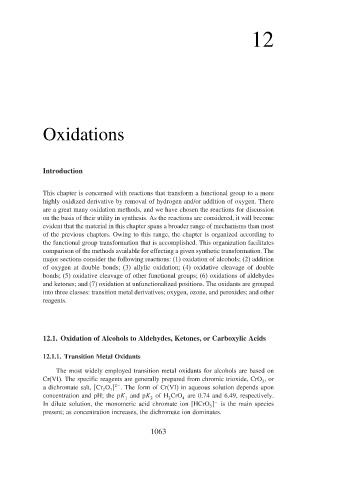Page 1087 - Advanced Organic Chemistry Part B - Reactions & Synthesis
P. 1087
12
Oxidations
Introduction
This chapter is concerned with reactions that transform a functional group to a more
highly oxidized derivative by removal of hydrogen and/or addition of oxygen. There
are a great many oxidation methods, and we have chosen the reactions for discussion
on the basis of their utility in synthesis. As the reactions are considered, it will become
evident that the material in this chapter spans a broader range of mechanisms than most
of the previous chapters. Owing to this range, the chapter is organized according to
the functional group transformation that is accomplished. This organization facilitates
comparison of the methods available for effecting a given synthetic transformation. The
major sections consider the following reactions: (1) oxidation of alcohols; (2) addition
of oxygen at double bonds; (3) allylic oxidation; (4) oxidative cleavage of double
bonds; (5) oxidative cleavage of other functional groups; (6) oxidations of aldehydes
and ketones; and (7) oxidation at unfunctionalized positions. The oxidants are grouped
into three classes: transition metal derivatives; oxygen, ozone, and peroxides; and other
reagents.
12.1. Oxidation of Alcohols to Aldehydes, Ketones, or Carboxylic Acids
12.1.1. Transition Metal Oxidants
The most widely employed transition metal oxidants for alcohols are based on
Cr(VI). The specific reagents are generally prepared from chromic trioxide, CrO ,or
3
a dichromate salt, Cr O . The form of Cr(VI) in aqueous solution depends upon
2−
7
2
concentration and pH; the pK and pK of H CrO are 0.74 and 6.49, respectively.
1 2 2 4
−
In dilute solution, the monomeric acid chromate ion HCrO is the main species
3
present; as concentration increases, the dichromate ion dominates.
1063

